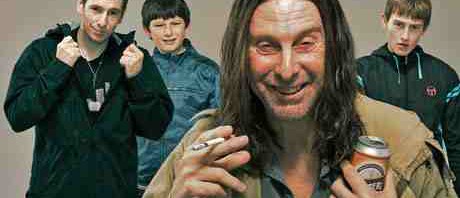
Local councillors worried that Shadsworth would be likened to the Channel 4 series Shameless. Photograph: Channel 4
A minor watershed might have been reached when, earlier this year, Southwark Council banned the use of two of its estates by film crews.
The association’s chair pointed out that “over time, it was the same subjects being used”. Drugs, violence, general “antisocial behaviour”, all no longer have one of their readymade concrete backdrops.
The estates in question, Aylesbury and Heygate, had become especially sexily dilapidated after many residents were removed to make way for a seemingly infinitely postponed redevelopment programme.
It’s surely a matter of time before other tenants’ associations follow suit, and enforce restrictions on the filming both of fiction and the ever-more creepily anthropological strain of prole-misery documentary.
The inhabitants of the Shadsworth estate in Blackburn, subject of the BBC’s Trouble on the Estate which was screened this week, for instance, might be wishing they had done so.
Especially since several of the residents filmed have actually answered back. After being portrayed here as a stereotypically feckless welfare-dependent single mum, one of the show’s “stars” Olwen Page was quoted as saying:
“The fact is I have been put on the sick because I’m struggling physically because of depression. The programme was edited in a way that didn’t show that. They didn’t put that I have been through domestic violence and I have low self-esteem and when I go to the jobcentre they make me feel low and dirty and it’s degrading.”
The BBC states that the programme does include interviews with Page in which she talks of taking antidepressants and her history of domestic abuse. It also disputes other residents’ claims that the programme-makers encouraged youths to put their hoods up, to look especially menacing.
Blackburn MP Jack Straw has vowed to complain to BBC governors, saying that Shadsworth was portrayed as if it was “an uncharted part of Africa”. And maybe most tellingly of all, local councillors worried about whether after the broadcast Shadsworth would always be seen as a “Shameless estate”.
But where does reality end here and fiction begin? Models rather than “real people” populate the brochure of ad agency Iris, which decided to show the “benefits package” it offers its employees via a series of hysterical proleface cliches, with protagonists watching Jeremy Kyle, smoking while pregnant and loitering on concrete walkways.
The agency, which faced wide condemnation this week, is based in Southwark, just up the road from the film directors’ dilapidated estates of choice. In fact, the presence of ad agencies and the like is part of the process of rent increases and gentrification that forces estate dwellers out. There’s something almost macabre about the unknowing cruelty of the brochure, Marie Antoinette’s farm relocated to SE1. This display of de haut en bassneering was, of course, “inspired by Shameless”.
What is it about council estates that lend themselves to this kind of mummery? Would an area of pinched leafy semis be described as a “Reginald Perrin estate”? Do gentrified areas of the capital necessarily evoke This Life? They don’t, largely because these are the kind of places that most of those who work in the media grew up in and moved to, respectively. The areas that they depict are known largely from television. They bear as much relation to their lived reality as The Wire.
However, the approach is a little older than this might imply. The die was cast when estates, back at the time when they were still considered futuristic, were depicted as horrifying, anti-human dystopias in fiction, long before they became so in documentary and sociology. Often, directors would travel to capture them in their pristine state – books are burned in the LCC’s Alton Estate in François Truffaut’s Fahrenheit 451, for instance. But the overwhelming example of this is surely Thamesmead, in south-east London, fixed so permanently by Stanley Kubrick as the home of “Municipal Flatblock A“, the apartment of young Alex and his thuggish Droogs. Kubrick’s image of a cold, futuristic, harsh place creating a people equally so is obviously far from the more mundane, worn, semi-suburban environs of Shameless and Shadsworth, but has been remarkably persistent, from “Come to Daddy“, Chris Cunningham’s mock-horror video for the Aphex Twin, to the asbo superheroes of cult television series Misfits.
Despite the predictability of its setting, Misfits was unusual, as it didn’t conform to type – in fact, it takes its paranormal characters more seriously than most documentary makers take their apparently real subjects. Like The League of Gentlemen, but unlike the more obvious sneering of, say, Little Britain, its caricatures are affectionate and convincing. They give the impression that the writers and directors may have previously met, may even have been people like that. Such acquaintance is rare enough, however, for estates to be well advised in keeping the cameras out.
• This article was amended on 13 September 2012, to add the BBC’s response to claims the programme-makers failed to include reference to Olwen Page’s depression and history of domestic abuse, and that they encouraged youths to put their hoods up
See also:



3 Responses
ah i see the bbc the friends of atos who do nothing wrong but kill now i see bbc who cant say anything bad about its partner atos and now i see bbc doing shitte work are they friends also with our gloroius torys who kill us daily jeff3 ah now i see bbc
this is typical of the BBC supposedly impartial lets have mass non payment of licence fee
The BBC are a joke, a farce, and sadly now beyond rescue. They are the last channel you tune into in order to get any real and unbiased news. They are simply a government mouthpiece. Shame on them for becoming such a vile thing.